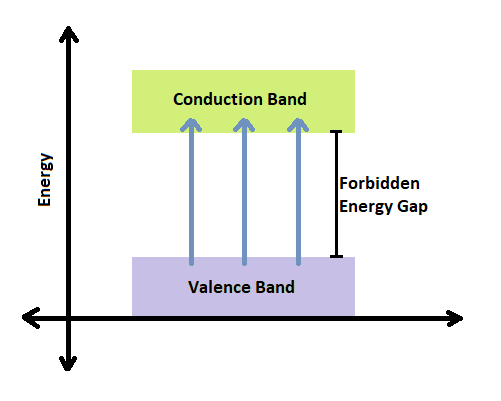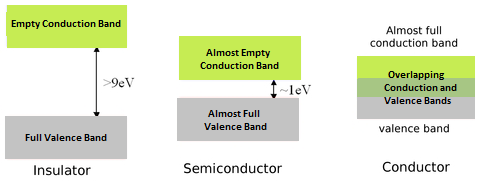
The forbidden energy gap can be overcome on thermal agitation by light. The substance is
(A) An insulator
(B) A conductor
(C) A semiconductor
(D) A superconductor
Answer
140.4k+ views
Hint: In conductors and superconductors, the conduction and valence bands are overlapped, so there is already no forbidden energy gap. In insulators, the forbidden energy gap is too large to be overcome by thermal excitation. In semiconductors, the forbidden energy gap is moderate and can be overcome.
Complete step by step solution:
First of all, we need to have a clear idea of what the forbidden energy gap is.

The forbidden energy band gap is the energy difference between valence band and conduction band of a substance. As the name suggests, this energy region is forbidden, that is, no electron occupies this state. This gap between valence band and conduction band, also determines the classification on the basis of electrical conductivity of a material. On the basis of electrical conductivity, materials are categorized into three main types:
Insulators: Forbidden energy gap > 9eV
Semiconductors: Forbidden energy gap ≈ 1eV
Conductors: Forbidden energy gap < 1eV
The forbidden energy band gap for all three types is shown:

Therefore, in semiconductors, the forbidden energy gap is small and can be overcome by thermal agitation, that is, by increasing temperature, unlike insulators. So, as the temperature of the semiconductor is increased, the forbidden energy gap tends to decrease.
Option (C) is correct.
Note: There is also an explicit temperature dependence of the forbidden energy gap which can be mathematically expressed from the following relation: \[{E_g}(T) = {E_g}(0) - \dfrac{{\alpha {T^2}}}{{T + \beta }}\]
where, \[{E_g}(T)\] is the forbidden energy gap at absolute temperature T
\[{E_g}(0)\] is the intrinsic forbidden energy gap
\[\alpha \] and \[\beta \] are constants.
So, we can see the decrease in the forbidden energy gap on increasing temperature mathematically as well as theoretically. Hence, the forbidden energy gap can be overcome by thermal agitation in semiconductors but not in insulators.
Complete step by step solution:
First of all, we need to have a clear idea of what the forbidden energy gap is.

The forbidden energy band gap is the energy difference between valence band and conduction band of a substance. As the name suggests, this energy region is forbidden, that is, no electron occupies this state. This gap between valence band and conduction band, also determines the classification on the basis of electrical conductivity of a material. On the basis of electrical conductivity, materials are categorized into three main types:
Insulators: Forbidden energy gap > 9eV
Semiconductors: Forbidden energy gap ≈ 1eV
Conductors: Forbidden energy gap < 1eV
The forbidden energy band gap for all three types is shown:

Therefore, in semiconductors, the forbidden energy gap is small and can be overcome by thermal agitation, that is, by increasing temperature, unlike insulators. So, as the temperature of the semiconductor is increased, the forbidden energy gap tends to decrease.
Option (C) is correct.
Note: There is also an explicit temperature dependence of the forbidden energy gap which can be mathematically expressed from the following relation: \[{E_g}(T) = {E_g}(0) - \dfrac{{\alpha {T^2}}}{{T + \beta }}\]
where, \[{E_g}(T)\] is the forbidden energy gap at absolute temperature T
\[{E_g}(0)\] is the intrinsic forbidden energy gap
\[\alpha \] and \[\beta \] are constants.
So, we can see the decrease in the forbidden energy gap on increasing temperature mathematically as well as theoretically. Hence, the forbidden energy gap can be overcome by thermal agitation in semiconductors but not in insulators.
Recently Updated Pages
Young's Double Slit Experiment Step by Step Derivation

Difference Between Circuit Switching and Packet Switching

Difference Between Mass and Weight

JEE Main Participating Colleges 2024 - A Complete List of Top Colleges

JEE Main Maths Paper Pattern 2025 – Marking, Sections & Tips

Sign up for JEE Main 2025 Live Classes - Vedantu

Trending doubts
JEE Main 2025 Session 2: Application Form (Out), Exam Dates (Released), Eligibility, & More

JEE Main 2025: Derivation of Equation of Trajectory in Physics

A point charge + 20mu C is at a distance 6cm directly class 12 physics JEE_Main

JEE Main Exam Marking Scheme: Detailed Breakdown of Marks and Negative Marking

Learn About Angle Of Deviation In Prism: JEE Main Physics 2025

Electric Field Due to Uniformly Charged Ring for JEE Main 2025 - Formula and Derivation

Other Pages
JEE Advanced Marks vs Ranks 2025: Understanding Category-wise Qualifying Marks and Previous Year Cut-offs

JEE Main 2025: Conversion of Galvanometer Into Ammeter And Voltmeter in Physics

Degree of Dissociation and Its Formula With Solved Example for JEE

Electric field due to uniformly charged sphere class 12 physics JEE_Main

Dual Nature of Radiation and Matter Class 12 Notes: CBSE Physics Chapter 11

Formula for number of images formed by two plane mirrors class 12 physics JEE_Main




